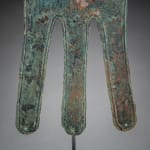Urartian Bronze Fitting with Bird, Boar and Hare Motifs, 900 BCE - 600 BCE
Bronze
25.7 x 14.7 cm
10 1/8 x 5 3/4 in
10 1/8 x 5 3/4 in
OF.251
Further images
The kingdom of Urartu, originally a confederation of numerous tribes from Eastern Anatolia, was one of the most powerful states in the Ancient Near East during the first half of...
The kingdom of Urartu, originally a confederation of numerous tribes from Eastern Anatolia, was one of the most powerful states in the Ancient Near East during the first half of the first millennium BC, constituting one of the fearest rivals of the Assyrian Empire. It was in the 9th century BC under Shalmaneser III (858-824) that the Urartian state developed a centralised system with several interconnected palace-fortresses placed on high rock outcrops.
Yet our knowledge of Urartian culture and history is mostly based on epigraphic evidence found especially in the area of Lake Van and in the Assyrian chronicles. From these sources, we know that during the 8th century BC Urartu expanded from Northern Turkey and Armenia, into Azerbaijan, Kurdistan and the Euphrates region, eventually coming into friction with the Assyrians and the Persians. Most of their military campaigns were indeed aimed at acquiring silver, copper and iron ores for their intensive metal-smithing industry.
Yet our knowledge of Urartian culture and history is mostly based on epigraphic evidence found especially in the area of Lake Van and in the Assyrian chronicles. From these sources, we know that during the 8th century BC Urartu expanded from Northern Turkey and Armenia, into Azerbaijan, Kurdistan and the Euphrates region, eventually coming into friction with the Assyrians and the Persians. Most of their military campaigns were indeed aimed at acquiring silver, copper and iron ores for their intensive metal-smithing industry.





